Revision Notes for CBSE Class 11 Maths Chapter 14 (Probability) - Free PDF Download
Free PDF download of Class 11 Maths revision notes & short key-notes for Probability of Chapter 14 to score high marks in exams, prepared by expert mathematics teachers from latest edition of CBSE books.
Probability Class 11 Notes Maths - Basic Subjective Questions
Section–A (1 Mark Questions)
1. While shuffling a pack of 52 playing cards, 2 are accidentally dropped. Find the probability that the missing cards to be of different colours.
Ans. We know that out of 52 playing cards, 26 are of red and 26 of black colour.
$\therefore P$ (Both cards of different colour)
$$\begin{aligned}=\frac{{ }^{26} C_1 \times{ }^{26} C_1}{{ }^{52} C_2}=\frac{26 \times26}{\left(\frac{52 \times 51}{2}\right)} & =\frac{26}{51} . \\\therefore \text { Required probability } & =\frac{61 \times 2 !}{7 !} \\& =\frac{6 ! \times 2}{7 \times 6 !}=\frac{2}{7} .\end{aligned}$$
2. The probability that a person visiting a zoo will see the giraffe is 0.72, the probability that he will see the bears is 0.84 and the probability that he will see both is 0.52. State whether the given statement is true or false.
Ans. Given that:
P (to see giraffe) = 0.72
P (to see giraffe) = 0.72
P ( to see both giraffe and bears) = 0.52
$\therefore$ P ( to see giraffe or bear)
= P ( to see giraffe) + P ( to see bear) - P( to see both) = 0.72 + 0.84 - 0.52
= 1.04 which is not possible
Hence, the given statement is false.
3. A single letter is selected at random from the word ‘PROBABILITY’. The probability that it is a vowel is.
Ans. Total number of alphabets in the word ‘PROBABILITY’ = 11
Number of vowels = 4
$\therefore$ Required probability $=\frac{4}{11}$ .
4. Seven persons are to be seated in a row. What is the probability that two particular persons sit next to each other.
Ans. The two particular persons are to be seated next to each other then, they form one group.
Now the permutation of 6 persons and total number of permutations of 7 persons =7!
$\therefore$ Required probability =$\frac{6!\times2!}{7!}$
=$\frac{6!\times2}{7\times6!} =\frac{2}{7}$
5. If A and B are two events associated with a random experiment such that $P(A)=0.3, P(B)=0.2$ and $P(A\cap B)=0.1$ then the value of $P(A)=0.3, P(B)=0.2 and P(A\cap \bar{B})=0.1$ is_____.
Ans. Given that: $P(A)=0.3, P(B)=0.2$ and $P(A\cap B)=0.1$
$P(A\cap \bar{B})=P(A)-P(A\cap B)$
=0.3-0.1
=0.2
Hence, the value of the $P(A\cap \bar{B})$ is 0.2.
Section–B (2 Marks Questions)
6. Three numbers are chosen from 1 to 20. Find the probability that they are not consecutive.
Ans. Set of three consecutive numbers from 1 to 20 are $1,2,3 ; 2,3,4 ; 3,4,5 ; \ldots, 18,19,20$.
So the probability that the numbers are
$$\begin{aligned}& \text { consecutive }=\frac{18}{{ }^{20} C_3} \\& =\frac{\frac{18}{20 !}}{3 ! \times 17 !}=\frac{18.3 ! .17 !}{20 !} \\& =\frac{18 \times 3 \times 2 \times 17 !}{20 \times 19 \times 18 \times 17 !} \\& =\frac{3 \times 2}{20 \times 19}=\frac{3}{190} \\& \therefore P(\text { Three numbers are not consecutive }) \\& =1-\frac{3}{190}=\frac{187}{190} .\end{aligned}$$
7. 6 boys and 6 girls sit in a row at random. Find the probability that all the girls sit together.
Ans. If all the girls sit together, then we consider it as 1 group.

$\therefore$ Total number of arrangements of 6+1=7 persons in a row =7!
and the girls also interchanged their places with 6! ways.
$$\begin{aligned}\therefore \text { Required probability } & =\frac{6 ! \times 7 !}{12 !} \\& =\frac{6 \times 5 \times 4 \times 3 \times 2 \times 7 !}{12 \times 11 \times 10 \times9\times 8 \times 7 !} \\& =\frac{1}{132},\end{aligned}$$
8. If A and B are mutually exclusive events, then show that $P(A)\leq P(\bar{B})$ .
Ans. For mutually exclusive events.
$$\begin{aligned}& P(A \cap B)=0 \\& \therefore P(A \cup B)=P(A)+P(B)[\because P(A \cap B)=0] \\& \Rightarrow P(A)+P(B) \leq 1 \\& \Rightarrow P(A)+1-P(\bar{B}) \leq 1[\because P(B)=1-P(\bar{B})] \\& \Rightarrow P(A)-P(\bar{B}) \leq 0 \\& \Rightarrow P(A) \leq P(\bar{B}) .\end{aligned}$$
9. If the odds in favour of an event be $\frac{3}{5}$ , then what is the probability of occurrence of event.
Ans. Let the given event be $E$ and $P(E)=x$
Odds in favour of $E=\frac{P(E)}{1-P(E)}$
$$\begin{aligned}& \Rightarrow \frac{P(E)}{1-P(E)}=\frac{3}{5} \Rightarrow \frac{x}{1-x}=\frac{3}{5} \\& \Rightarrow 5 x=3-3 x \Rightarrow x=\frac{3}{8} .\end{aligned}$$
10. If the letters of the word ALGORITHM are arranged at random in a row, what is the probability that the letters GOR must remain together as a unit.
Ans. The Word ALGORITHM has 9 letters.
If GOR remain together, then it will act as a single letter.
$\therefore$ Number of letters
$$=A L \text { GOR } I T H M=6+1=7$$
Number of words $=7$ !
And the total number of words from ALGORITHM $=9$ !
So, the required probability
$$=\frac{7 !}{9 !}=\frac{7 !}{9 \times 8 \times 7 !}=\frac{1}{72}$$
Hence, the required probability $=\frac{1}{72}$.
11. Six new employees, two of whom are married to each other, are to be assigned six desks that are lined up in a row. If the assignment of employees to desks is made randomly, what is the probability that the married couple will have non-adjacent desks.
Ans. Number of desks occupied by one couple $=1$
Only $(4+1)=5$ persons to be assigned.
$\therefore$ Number of ways of assigning these 5 persons $=5$ ! $\times 2$ !
Total number of ways of assigning these 6 persons $=6$ !
$\therefore$ Probability that a couple has adjacent desk $=\frac{51 \times 2 !}{6 !}=\frac{1}{3}$
So, the probability that the married couple will have no-adjacent desks $=1-\frac{1}{3}=\frac{2}{3}$ Hence, the required probability $=\frac{2}{3}$.
12. A card is drawn from a deck of 52 cards. Find the probability of getting a king or a heart or a red card.
Ans. Total number of cards $=52$
Favourable events $=4$ kings +13 hearts + $26 \mathrm{red}-13-2=28$
$\therefore$ Required probability $=\frac{28}{52}=\frac{7}{13}$.
13. In a large metropolitan area, the probabilities are 0.87, 0.36, 0.30 that a family (randomly chosen for a sample survey) owns a colour television set, a black and white television set, or both kinds of sets. What is the probability that a family owns either anyone or both kinds of sets.
Ans. Let $E_1$ be the even that a family owns colour television set and $E_2$ be the event that the family owns black and white television set.
Given that, $P\left(E_1\right)=0.87, P\left(E_2\right)=0.36$ and $P\left(E_1 \cap E_2\right)=0.30$
$\therefore$ The probability that a family owns either colour television set or black and white television set
$$\begin{aligned}P\left(E_1 \cup E_2\right) &=P\left(E_1\right)+P\left(E_2\right)-P\left(E_1 \cap E_2\right) \\& =0.87+0.36-0.30=0.93\end{aligned}$$
PDF Summary - Class 11 Maths Probability (Chapter 14)
Probability is a numerical measure of the uncertainty of diverse phenomena. It can range from $0$ to $1$ a positive value.
The phrases 'probably', 'doubt’, ‘most probably', 'chances' and so on, all have an element of ambiguity in them.
$\text{Probability=}\dfrac{\text{no}\text{. of favourable outcome }}{total\text{ no}\text{. of outcomes}}$
Approaches to Probability:
i. Statistical approach: Observation & data collection
ii. Classical approach: Only Equal probable events
iii. Axiomatic method: For real-life situations. It has a strong connection to set theory.
Random Experiments:
i. There are multiple possible outcomes.
ii. It is impossible to know the outcome ahead of time.
Outcomes:
An outcome is a probable result of a random experiment.
Sample space refers to the set of all possible results of a random experiment. The letter S stands for it. For example, in a coin toss, the sample space is Head, Tail.
Each element of the sample space is referred to as a sample point. For example, in a coin flip, the head is a sample point.
Event:
An event is a collection of favourable outcomes.
An event is defined as a subset $E$ of a sample space $S$. For example, suppose you get an unusual result when you roll a dice.
Occurrence of an event:
The occurrence of an event $E$ in a sample space $S$ is said to have occurred if the experiment's outcome $\omega $ is such that $\omega \in E$. We say that the event E did not happen if the outcome $\omega $ is such that $\omega \in E$.
Types of Event
i. Impossible and Sure Events
ii. Simple Event
iii. Compound Event
Impossible and Sure Events:
Events that are both impossible and certain are described by the empty set $\phi $ and the sample space $S$. The impossible event is denoted by $\phi $, and the entire sample space is referred to as the Sure Event.
For example, while rolling a dice, an impossible event is when the number is greater than 6 and a sure event is when the number is less than or equal to 6.
Simple (or elementary) event: A simple event has only one sample point of a sample space.
There are exactly n simple occurrences in a sample space with n different items. For example, if you roll a dice, a simple event could be receiving a four.
Compound Event: A compound event is one in which there are multiple sample points.
For example, in the case of rolling a die, a simple event could be the event of receiving a four.
Algebra of Events:
i. Complementary Event
ii. Event ‘A or B’
iii. Event ‘A and B’
iv. Event ‘A but not B
Complementary Event
Complementary event to $\text{A= }\!\!'\!\!\text{ not A }\!\!'\!\!\text{ }$
Example: If event $\text{A=}$Event of getting odd number in throw of a die, that is \[\left\{ \text{1, 3, 5} \right\}\] Then, Complementary event to $\text{A=}$ Event of getting even number in throw of a die, that is \[\left\{ \text{2, 4, 6} \right\}\text{ }\!\!~\!\!\text{ }\]
$\text{A }\!\!'\!\!\text{ =}\left\{ \text{ }\!\!\omega\!\!\text{ : }\!\!\omega\!\!\text{ }\in \text{S and }\omega \notin \text{A} \right\}=S-A$ (Where $\text{S}$ is the Sample Space)
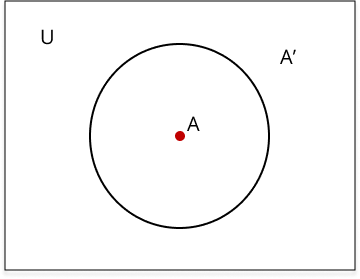
Event (A or B):
\[\text{A}\cup \text{B }\!\!~\!\!\text{ }\] is known as the union of two sets $\text{A}$ and $\text{B}$, it contains all those elements which are present in either of the two sets.
If the sets $\text{A}$ and $\text{B}$ correspond to two events in a sample space, then \[\text{A}\cup \text{B}\] is the event ‘either $\text{A}$ or $\operatorname{B}$ or both’. This event \[A~\cup B\] is also called\[\text{A or B}\]
Event
\[\text{A or B = A}\cup \text{B = }\!\!\{\!\!\text{ }\omega:\omega\!\!\text{ }\in \text{A or }\omega \in \text{B }\!\!\}\!\!\text{ }\]
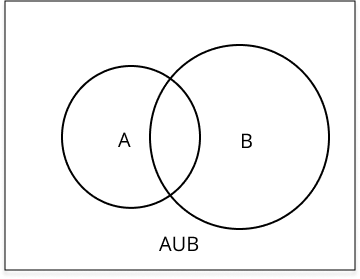
Event $\text{ }\!\!'\!\!\text{ A and B }\!\!'\!\!\text{ }$:
\[\text{A}\cap \text{B}\] is known as the intersection of two sets $\text{A}$ and $\text{B}$, it contains all those elements which are common in both the two sets. i.e., which belong to both\[\text{A and B}\]. If $A$ and $\text{B}$ are two events, then the set A\[\text{A}\cap \text{B}\] denotes the event \[\text{A and B}\].
Thus, \[\text{A }\cap \text{ B = }\!\!\{\!\!\text{ }\!\!\omega\!\!\text{ : }\!\!\omega\!\!\text{ }\in \text{A and }\!\!\omega\!\!\text{ }\in \text{B }\!\!\}\!\!\text{ }\!\!~\!\!\text{ }\]
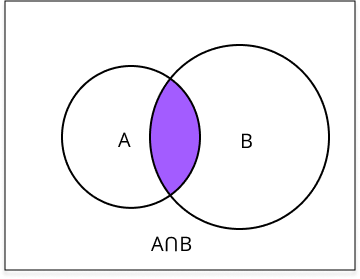
Event $\text{ }\!\!'\!\!\text{ A but not B }\!\!'\!\!\text{ }$
\[\text{A--B}\] is the set of all those elements which are in $A$ but not in $\text{B}$ . Therefore, the set \[~\text{A--B}\] may denote the event ‘ $A$but not $\text{B}$ ’.
\[\text{A -- B = A }\cap \text{ B }\!\!'\!\!\text{ }\!\!~\!\!\text{ }\]
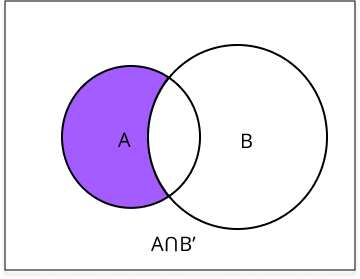
Mutually exclusive events
Events $A$ and $\text{B}$ are said to be mutually exclusive if the occurrence of one of them precludes the occurrence of the other, i.e., if they can't happen at the same time.
A die is thrown, for example. All even outcomes are events $A$, and all odd outcomes are events $\text{B}$. Then $A$ and $\text{B}$ are mutually exclusive events, and they cannot happen at the same time.
A sample space's simple events are always mutually exclusive.
Exhaustive events:
Sample space contains a lot of events together.
Example: A die is thrown.
Event $\text{A=}$ All even outcome and event $\text{B=}$ All odd outcome. Even$A$ & $\text{B}$ together forms exhaustive events as it forms Sample Space.
Axiomatic Approach to Probability:
Another way of explaining probability by using axioms are rules is called the Axiomatic approach.
Let $S$ be the sample space of a random experiment. The probability $P$ is a real valued function whose domain is the power set of $S$ and range is the interval \[\left[ \text{0,1} \right]\] satisfying the following axioms
i. For any event $E,$$P\left[ E \right]\ge 0$
ii. $P\left[ S \right]=1$
iii. If $E$ and $F$ are mutually exclusive events, then $P\left( E\cup F \right)=P\left( E \right)+P\left( F \right)$
It follows from (III) that $\text{P}\left( \phi \right)\text{=0}$ . Let $\text{F=}\phi $ and $\text{E=}\phi $ be two disjoint events,
$\therefore \text{P}\left( E\cup \phi \right)=P\left( E \right)+\text{P}\left( \phi \right)\text{ or P}\left( \text{E} \right)=P\left( E \right)\text{+P}\left( \phi \right)\text{i}\text{.e P}\left( \phi \right)\text{=0}$
Let $S$ be a sample space containing outcomes ${{\omega }_{1}},{{\omega }_{2}},....{{\omega }_{n}}$ i.e., $S=\left\{ {{\omega }_{1}},{{\omega }_{2}}.....,{{\omega }_{n}} \right\}$ then
i. $0\le P\left( {{\omega }_{i}} \right)\le 1$ for each ${{\text{ }\!\!\omega\!\!\text{ }}_{\text{i}}}\in \text{S}$
ii. $P\left( {{\omega }_{1}} \right)+P\left( {{\omega }_{2}} \right)+....+P\left( {{\omega }_{n}} \right)=1$
iii. For any event $E,P\left( E \right)=\sum P\left( {{\omega }_{i}} \right),{{\omega }_{i}}\in A$
iv. $P\left( \phi \right)=0$
Probabilities of equally likely outcomes:
Let\[\text{P}\left( {{\text{ }\!\!\omega\!\!\text{ }}_{\text{i}}} \right)\text{ = p}\] , for all \[{{\text{ }\!\!\omega\!\!\text{ }}_{\text{i}}}\in \text{S}\] where\[\text{0 }\le \text{ p }\le \text{ 1}\] , then $p=\dfrac{1}{n}$ where $\text{n=}$number of elements.
Let $S$ be a sample space and E be an event, such that $\text{n}\left( \text{S} \right)\text{=n}$ and$n\left( E \right)=m$ . If each outcome is equally likely, then it follows that $\text{P}\left( \text{E} \right)\text{=}\dfrac{\text{m}}{\text{n}}$
$=\dfrac{\text{Number of outcomes favourable to E}}{Total\text{ possible outcomes}}$
Probability of the event ‘\[\mathbf{A}\text{ }\mathbf{or}\text{ }\mathbf{B}\] :
\[\text{P(A}\cup \text{B) = P}\left( \text{A} \right)\text{ + P}\left( \text{B} \right)\text{ - P}\left( \text{A}\cap \text{B} \right)\text{ }\!\!~\!\!\text{ }\]
Probability of the event \[\text{A and B }\!\!~\!\!\text{ }\] \[\text{P}\left( \text{A}\cap \text{B} \right)\text{ = P}\left( \text{A} \right)\text{ + P}\left( \text{B} \right)\text{ - P}\left( \text{A}\cup \text{ B} \right)~\]
Probability of the event ‘Not $\text{A}$ ’
\[\text{P}\left( \text{ A }\!\!'\!\!\text{ } \right)\text{ = P}\left( \text{not A} \right)\text{ = 1 -- P}\left( \text{A} \right)\text{ }\!\!~\!\!\text{ }\]
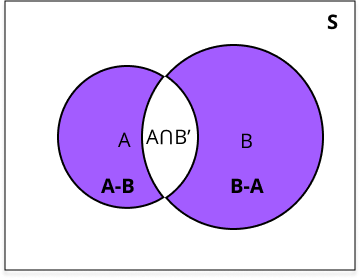
Related Study Materials for Class 12 Maths Chapter 14
Probability Related Other Study Materials |
Chapter-wise Links for Mathematics Class 11 Notes
S.No. | NCERT Solutions Class 11 Maths All Chapters |
1 | |
2 | |
3 | |
4 | |
5 | |
6 | |
7 | |
8 | |
9 | |
10 | |
11 | Chapter 11 - Introduction To Three Dimensional Geometry Notes |
12 | |
13 |
Related Important Links for Mathematics Class 11
Along with this, students can also download additional study materials provided by Vedantu for Maths Class 11–
S.No. | Important Study Material for Maths Class 11 |
1 | |
2 | |
3 | |
4 | |
5 | |
6 | |
7 | |
8 | |
9 | |
10 |























